|

|
Amphidiploid Arilbreds
|
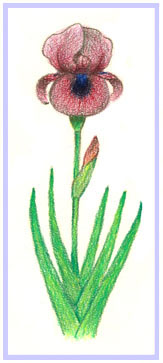 Early
arilbred breeding, which focused on crossing diploid oncocycli with
diploid or tetraploid tall beardeds, was greatly hampered by the
sterility of most of the progeny, not to mention difficulties in
making the crosses and germinating the seeds. Except for an
occasional break, such as 'Ib-Mac' or 'Capitola', in which a fertile
amphidiploid was produced fortuitously, there was little opportunity
to breed the arilbreds for desired qualities.
Early
arilbred breeding, which focused on crossing diploid oncocycli with
diploid or tetraploid tall beardeds, was greatly hampered by the
sterility of most of the progeny, not to mention difficulties in
making the crosses and germinating the seeds. Except for an
occasional break, such as 'Ib-Mac' or 'Capitola', in which a fertile
amphidiploid was produced fortuitously, there was little opportunity
to breed the arilbreds for desired qualities.
This situation eventually changed when C. G.
White produced a family of fertile amphidiploid arilbreds, with two
sets of aril chromosomes and two sets of tall bearded chromosomes. He
did not keep breeding records, so we cannot be certain how this was
accomplished. When an enormous number of seedlings are raised, some
amphidiploids will be produced from unreduced gametes or other
chromosome anomalies. Most modern arilbreds are descended from the C.
G. White amphidiploids. Most "halfbreds" are members of this fertile
family, while those less or more than half aril are typically
infertile or of limited fertility.
This family can be expanded by crossing the
tetraploid arils with the 48-chromosome bearded irises. This is
important for expanding the genetic base of both the aril and the
bearded component. The arils used in White's breeding were advanced
generation oncogelias and oncocyclus hybrids, which he renewed
annually from seed. Some species were doubtless more strongly
represented in this mix than others. The "onco look" will always be a
desirable trait in arilbreds, but recent fertile arilbreds from
Regelia breeding are also interesting and desirable plants. On the
bearded side, C. G. White's arilbreds stem from early 20th-century
TBs. Using modern TBs and BBs should produce improved arilbreds,
contributing modern form, substance, and branching to the mix. If the
48-chromosome dwarfs and medians are used, fully fertile arilbred
medians result. Harald Mathes's 'Anacrusis' and its descendents are
examples of such breeding.
I plan to focus my work with this family on
fertile arilbred medians, including regeliabreds.
Progress to Date
2018 saw maiden bloom on the first batches of
seedlings from this work, crosses of 'Night Mood' x 'Werckmeister's
Beauty' and 'Sultry Dreams' x 'Werckmeister's Beauty'. Saddly,
however, the crosses seem to have been contaminated, with no aril
characteristics evident in the seedlings. One from 'Sultry Dreams' x
'Werckmeister's Beauty' bloomed for the first time in 2019, and its
veining and flower form encouraged me to think that it may truly be a
child of 'Werckmeister's Beauty'. I'm not at all certain of that, but
I am keeping it and using it as though it were the genuine
article. In 2017, encouraged by the apparent tetraploidy of an
Iris reichenbachii form from Mt. Vikos, Greece, I obtained
many pods from its pollen on 'Dunshanbe'. Not all seeds appeared
viable, but the total yield was still quite copious. No seedlings
yet, alas.
Further Reading
Bearded Species for
Breeding Arilbred Medians
Arilbred
Irises: A Little History
(AIS blog)
The
Legacy of 'Anacrusis'
(AIS blog)
Hall of Fame
Ib-Mac (C. G. Van Tubergen, BRS).
AB/OB , MB. Medium red bitoned blend. I. iberica x I.
macrantha. Van Tubergen, 1910. [44 chr.]
The first known amphidiploid arilbred,
resulting from an unreduced gamete from I. iberica.
Capitola (Frank Reinelt, R. 1940).
AB/OB, IMB, medium height, E. Dark red violet. 'William Mohr' x
'Ib-Mac'. 1940. [43 chr.]
'Ib-Mac's pollen-fertile offspring, once
again thanks to an unreduced gamete from the pod parent. 'Capitola'
was widely used in breeding, although mostly with TBs to produce the
quarterbred "Mohrs", there being few other fertile arilbreds at the
time to cross it with.
Kalifa Gulnare (Clarence G. White, R.
1954). Sdlg. 23B54. AB/OGB , EC, 34” (86 cm), E. S. pale orchid
lavender; F. same, heavily overlaid apricot buff. Parentage unknown.
Craig, 1955. [44 chr.]
Of the many important fertile amphidiploid
arilbreds produced by C. G. White in the 1950s, I selected 'Kalifa
Gulnare' for this list because of its almost ubiquitous presence in
the pedigree of the modern arilbreds, and its relative longevity as a
popular garden iris through the decades.
Welcome Reward (Eugene Sundt by Lois
Rich, R. 1971). Sdlg. S59119. AB/OB , 27" (69 cm), L. S. lilac veined
deeper, bronze flush part way up rib; F. gold bronze, haft veined
mahogany on gold, pinkish flush on lower half; dark brown signal;
golden brown beard; gold style crests. Austin W142-O (onco
interspecies) x 'Pink Formal'. Aril Society, 1971.
[44chr]
While almost all fertile amphidiploid
arilbreds in recent decades derive from the C. G. White varieties,
'Welcome Reward' is an exception: an amphidiploid oncobred of known
parentage, resulting from an unreduced gamete from its oncocyclus pod
parent. It has produced many important descendants.
Genetic Artist (Henry Danielson, R.
1971). Sdlg. F-66-1. AB/RB , 30” (76 cm), EM. Odd combination of
bronzy yellow and blue; center of petals to sides of ribs metallic
lavender blue; edges strongly colored red bronze with tints of henna;
beard lavender. 'Frost and Flame' x 'Vulcanus'. Mount Clare Iris
Gardens, 1972.
An alter ego to 'Welcome Reward', if you
will, is 'Genetic Artist', an amphidiploid regeliabred with many
interesting descendants. While it is easy to focus on oncocyclus
qualities as the object of arilbred breeding, this spendidly colored
iris reminds us that the Regelias also have unique colors, patterns,
and forms to contribute to the mix.
Anacrusis (Harald Mathes, R. 1992).
Sdlg. 88-MDB16. AB/OGB/ABM, 20” (51 cm), E. Oxblood red; red
black signal and beards. 'Dresden Gold' x T-IAM: ((I. iberica
x I. auranitica) x I. suaveolens (mellita)). Aril
Society, 1992.
The pollen parent is a colchicine-induced
tetraploid whose bearded ancestry comes entirely from the miniature
dwarf species I. suaveolens. This represents the first
significant incorporation into the fertile arilbred family of bearded
iris genes that are not from the garden TBs. 'Anacrusis' and its
descendants are indeed of median height, and there is great potential
here for launching a family of fertile arilbred medians. Its
descendant 'Concerto Grosso' won the C. G. White Medal in
2005.
Gallery
|
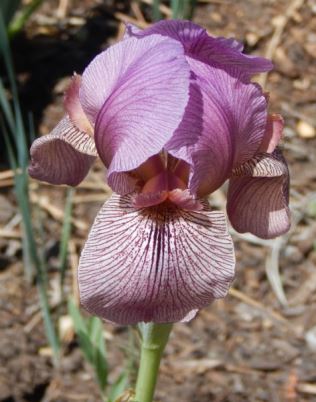
|
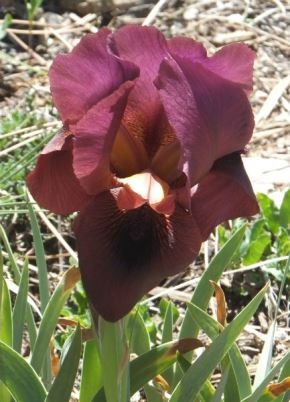
|
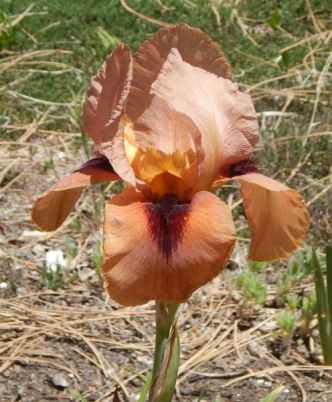
|
'Alakazam'
(Tasco, 2013)
|
'Anacrusis'
(Mathes, 1992)
|
'Iridescent
Orange'
(Mathes, 2001)
|
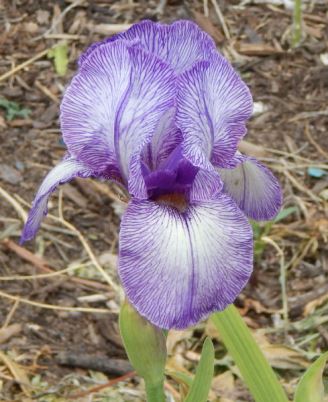
|
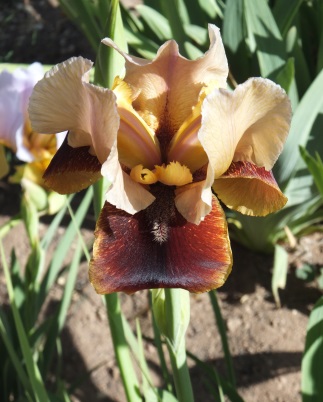
|
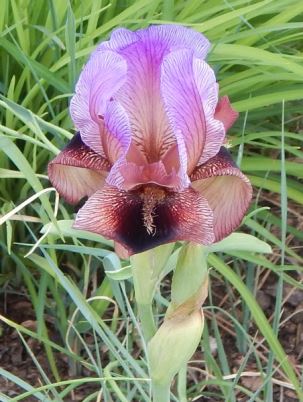
|
AB
'Jonnye's Magic'
(Rich by Whitely, 1992)
|
'Navajo
Velvet'
(McAllister, 2009)
|
'New
Vision'
(Tasco, 2012)
|

|

|
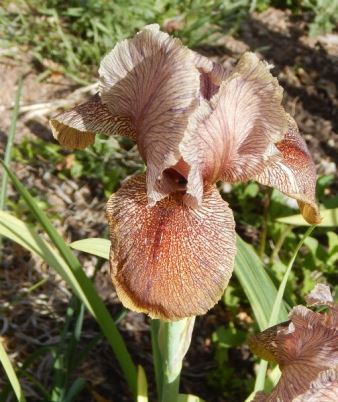
|
'Noble
Warrior'
(Tasco, 2006)
|
'Rare
Breed'
(Tasco, 2011)
|
'Sand
Dancer'
(Tasco, 2010)
|
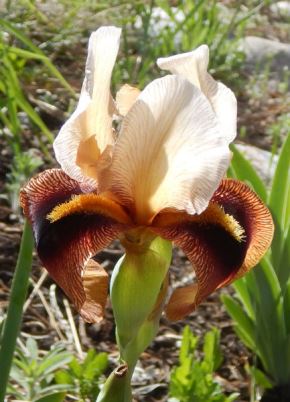
|
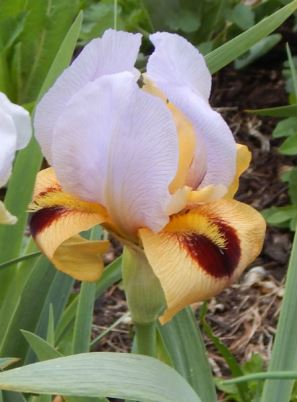
|
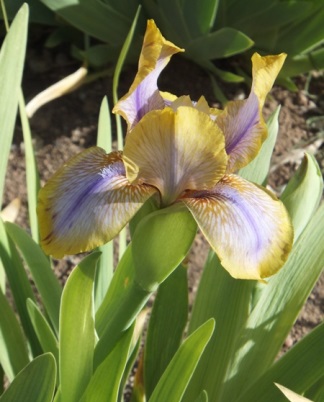
|
'Shaman's
Magic'
(Tasco, 2014)
|
'Silent
Sentry'
(Tasco, 2008)
|
'Stars
Over Chicago'
(H. Danielson, 1972)
|
|
|
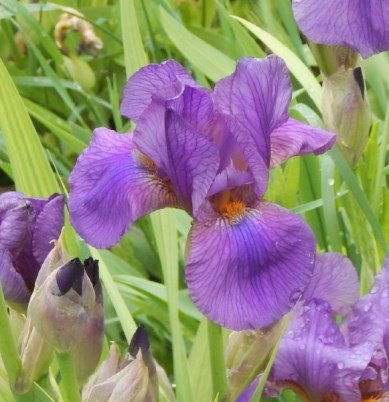
|
|
|
|
B015-06
'Sultry Dreams' X 'Werckmeister's Beauty'
|
|
Plant List
The list below shows the name of each plant I
currently grow for breeding purposes, the source, and the year
acquired.
Illustration: 'Concerto
Grosso' (Mathes '98): an amphidiploid arilbred from Mathes's
'Anacrusis' line.
Tom
Waters
September 2010
updated October
2019
Unless otherwise noted, all text
and illustrations copyright Tom Waters and all photographs copyright
Tom or Karen Waters. Please do not reproduce without
permission.
 Early
arilbred breeding, which focused on crossing diploid oncocycli with
diploid or tetraploid tall beardeds, was greatly hampered by the
sterility of most of the progeny, not to mention difficulties in
making the crosses and germinating the seeds. Except for an
occasional break, such as 'Ib-Mac' or 'Capitola', in which a fertile
amphidiploid was produced fortuitously, there was little opportunity
to breed the arilbreds for desired qualities.
Early
arilbred breeding, which focused on crossing diploid oncocycli with
diploid or tetraploid tall beardeds, was greatly hampered by the
sterility of most of the progeny, not to mention difficulties in
making the crosses and germinating the seeds. Except for an
occasional break, such as 'Ib-Mac' or 'Capitola', in which a fertile
amphidiploid was produced fortuitously, there was little opportunity
to breed the arilbreds for desired qualities.












